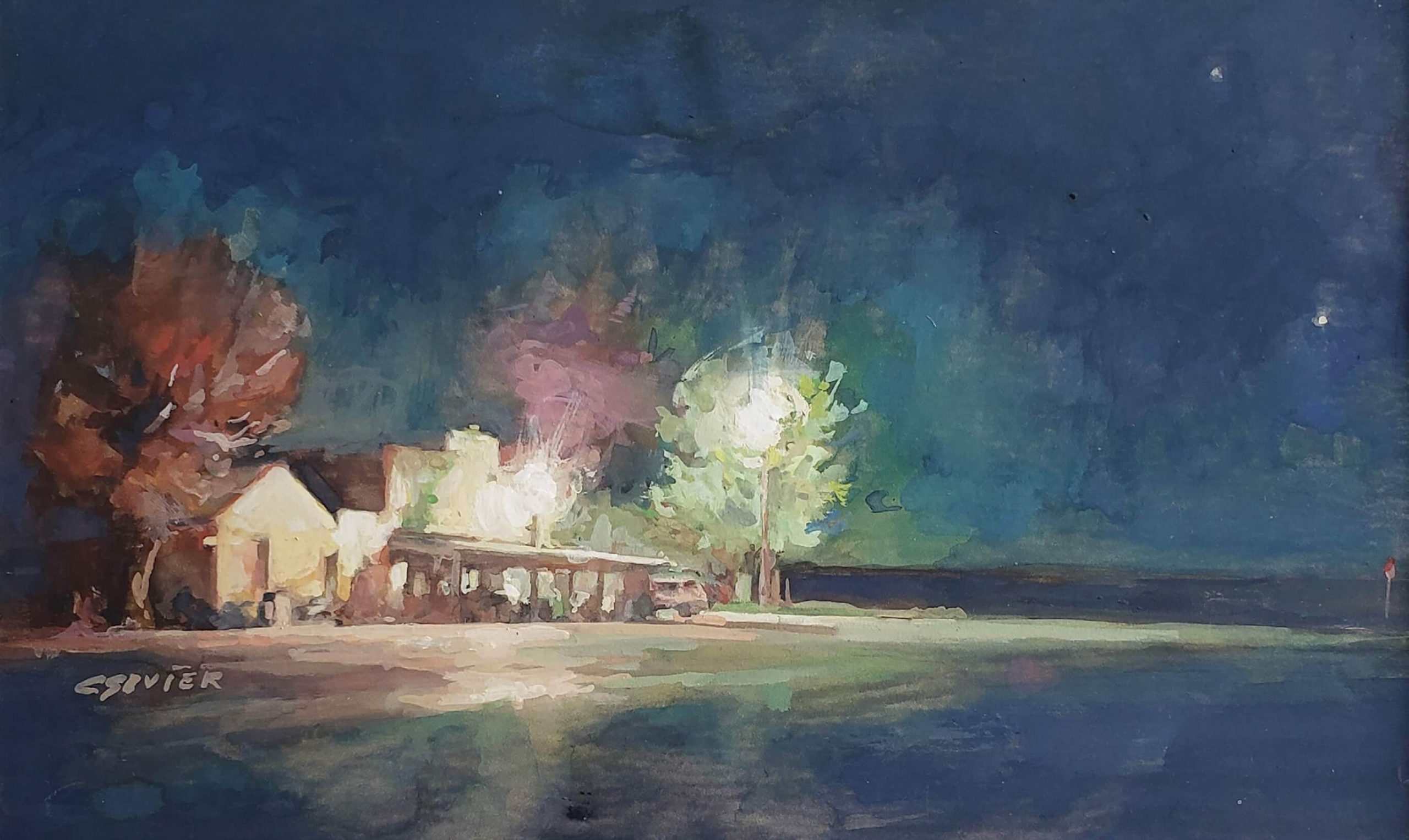
01 Aug Chessney Sevier: Poetry in Art
The first thing you notice is the light. The common thread running through Chessney Sevier’s art — whether etching or oil or encaustic — is her deft and masterful rendering of light. Sun illuminating a summer meadow. The neon of a country bar shining out into the night. Moonlight gracing the backs of horses.
Not all good artists know how to depict light well, and those who do seem to share a common trait: the ability to observe, closely; to truly see what is in front of them, and to translate that vivid reality onto the page or canvas. Sevier clearly possesses this ability, and has from a young age. “I learned the fundamentals from my mom,” she says. “She would always notice things like color, atmosphere, features in the landscape, basics that you never really notice until you try to paint it or draw it. Things like that she’d always point out, and that’s when I started drawing and seeing things a lot differently.”
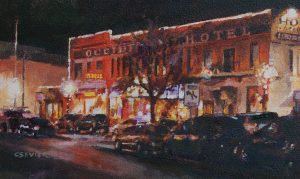
OCCIDENTAL HOTEL, BUFFALO, WYOMING | Acrylic on Gessobord | 4 x 6 inches
Sevier’s mother — the Northern Arapaho artist Jackie Sevier — started taking art classes when her children were young, “just to get a break,” Sevier says. “We lived in the middle of nowhere, so it’s amazing she found some [classes]. But it just changed our whole lives, because she started doing some shows, and teaching us things that I never thought of, you know, that your eyes are in the middle of your face, not at the top of your forehead like you might draw them,” she laughs.
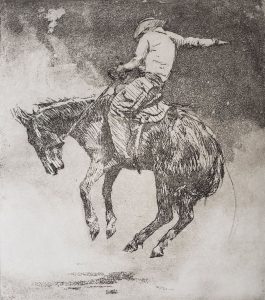
STARGAZER | Intaglio Etching | 6 x 6.5 inches
Raised in the rural Nebraska Sandhills, Sevier grew up making art and participating in rodeos, two passions that have stuck with her to this day. She attended Chadron State College on a full rodeo scholarship and chose to pursue a degree in fine art. She spent a stint as a graphic designer for Cabela’s before moving to Wyoming in 2001. Following in her footsteps, her teenage daughter now keeps them busy traveling around the state on the rodeo circuit.
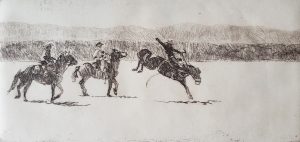
ROOM TO BREATHE | Etching | 2.75 x 6 inches
The place and its people firmly inform Sevier’s work, providing ample inspiration, though, even as her art depicts plenty of landscapes and horses and cowboys, she shies away from cliched images. “That’s one of the things that separates her work; it doesn’t look derivative,” says Kenneth Schuster, director and chief curator of the Brinton Museum in Big Horn, Wyoming. “It looks totally modern. She’s got the ability to be able to do that, which I think just puts her higher up on my list of favorite artists.”
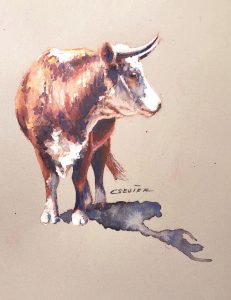
TEXAS RANGE COW | Gouache | 6 x 6 inches
It’s clear that her work builds on keen observation, a deep appreciation for beauty, and a desire to capture the truth in what she sees — not the West of the imagination. “Art is a thing of value when it comes from a person’s real sincerity about the West, or the people in it, or even their day-to-day life. I don’t know how many times I’ve seen a painting of a cowboy carrying a calf over the pommel of his saddle. In real life, I don’t know anybody who’s ever done that,” Sevier says with a sly laugh. “I just try to depict the things that I love, the things that are important to me, the things I want to express.”
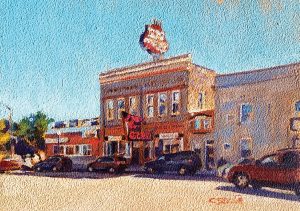
IRMA HOTEL, CODY, WYOMING | Acrylic on Gessobord | 5 x 3 inches
Sevier isn’t shy about admitting that she makes art for art’s sake, not for the market. “I’ve never done art to sell art,” she says. “I’ve just always wanted to create something that I want to create.” This personal approach sets her apart from other artists who may have a more self-promotional agenda. “It’s in keeping with her personality, I think,” says Schuster. “She’s just this superwoman, but she’s not in anybody’s face, she’s not bigger than life. She’s a very remarkable woman and a very fine artist who definitely has something to say. She’s not churning out potboilers just to make sales.”
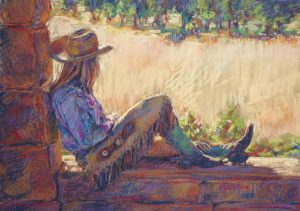
LAST ROSE OF SUMMER | Pastel on Sandpaper | 16 x 9 inches
Perhaps it’s this purity of intent that allows her to explore a wide range of mediums, from copper plate etching to oil and acrylic painting to encaustic. “She’s a very strong intaglio artist,” says Schuster. “I think her intaglio work is par excellence, and that’s been borne out by a lot of other institutions. But we also love her painting, which can go by quite unnoticed because she’s not somebody who’s going to turn out a big 30-by-40-inch canvas. She works small.”
Sevier would tell you that her skill in a variety of mediums is due in part to her passion — “I want to do it all! At least try it, anyway,” she says — but also to much more practical considerations. “This is a little crazy, but living in Wyoming, it kind of depends on temperature,” says Sevier. “I got into plein air for a long time and painted every single day outside, and I painted in a Ranger with a cab. But, now my studio isn’t very well heated, so I’ll use certain mediums that I can paint in the house in the wintertime. I know that sounds crazy, but it’s like I can do a gouache at the kitchen table and it’s warm in here!”
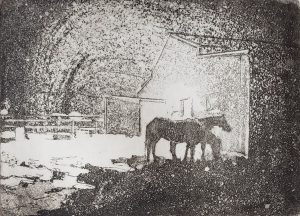
CHORES DURING THE STORM | Intaglio Etching | 4 x 3 inches
Practicality aside, Sevier’s work sings no matter the medium. The sincerity of her gaze and love for the world are apparent in her renderings, which capture the West’s quiet narratives. Sevier is reluctant to boast about her accomplishments, though the one story she does share with pride speaks volumes about her and her work. “One time, I was doing a show in Santa Fe … and one of the guys in there was this artist by the name of Mike Capron. And he’s just the neatest old guy, he’s been a cowboy his whole life. And he told me, he said ‘Your pieces are poetry.’ And that was really cool. That’s a big compliment to me. That’s the biggest compliment I’ve ever gotten. And maybe that sets my art apart. Not that it needs to be set apart, but maybe it sets it apart as an expression of me.”




Chessney Sevier
Posted at 20:42h, 10 AugustThank you for featuring my work and for the beautiful story of my life. I’m honored to take part.
Chessney